Yamuna above danger mark in Uttarakhand

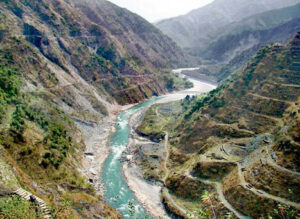
The Yamuna River, one of the major rivers in Uttarakhand, holds cultural, historical, and ecological significance in the region. Originating from the Yamunotri Glacier, the river meanders through the picturesque landscapes of Uttarakhand before flowing into other states. The town of Yamunotri, nestled in the Garhwal Himalayas, is a significant pilgrimage site as it marks the source of the Yamuna. Like its counterpart, the Ganges, the Yamuna is considered sacred in Hinduism, and its banks are dotted with temples and ghats that draw pilgrims seeking spiritual blessings.
The Yamuna’s journey through Uttarakhand contributes to the state’s biodiversity, supporting diverse ecosystems along its course. However, like many rivers in India, the Yamuna faces environmental challenges, including pollution and over-extraction of water. Efforts are underway to address these issues and restore the river’s health. The Yamuna, with its historical and cultural importance, serves as a lifeline for communities along its banks, providing water for agriculture, domestic use, and sustaining local economies. Balancing the preservation of its sacred and cultural value with sustainable management practices is crucial for ensuring the Yamuna’s continued significance in the region.
The Yamuna River’s significance extends beyond its role in religious practices and ecosystem support. As it traverses Uttarakhand, the Yamuna becomes an integral part of the region’s socio-economic fabric. The river’s waters are harnessed for agricultural irrigation, contributing to the fertility of the plains through which it flows. The rich alluvial soil deposited by the Yamuna has historically supported agriculture, enabling the cultivation of crops that form the backbone of the local economy.

Moreover, the Yamuna is a tributary of the Ganges, and its confluence with the Ganga holds particular cultural and ritualistic importance. The Sangam at Allahabad, where the Yamuna joins the Ganges and the mythical Saraswati River, is a site of the Kumbh Mela, one of the largest religious gatherings in the world, attracting millions of pilgrims.
However, the Yamuna is grappling with environmental challenges, primarily pollution resulting from industrial discharge and untreated sewage. Efforts to clean the river and promote sustainable practices are ongoing to ensure the preservation of its ecological balance and the well-being of the communities that depend on it. In essence, the Yamuna River in Uttarakhand embodies a delicate balance between its cultural, economic, and ecological roles, reflecting the intricate connection between rivers and the societies they nourish.
The Yamuna River in Uttarakhand is not only a source of sustenance for agriculture and a hub for cultural practices but also a key player in the state’s tourism sector. The picturesque landscapes along the Yamuna’s course, with the backdrop of the Himalayas, attract nature enthusiasts, adventure seekers, and tourists seeking tranquility. The towns and villages along the Yamuna offer a glimpse into the region’s rich heritage, with historical temples, vibrant markets, and traditional festivals.
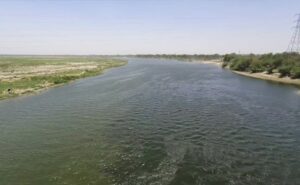
Additionally, the Yamuna contributes to Uttarakhand’s biodiversity, providing a habitat for various species of fish and supporting the surrounding flora and fauna. The riverbanks are home to a variety of bird species, making it an enticing destination for birdwatchers and wildlife enthusiasts.
However, like many rivers in India, the Yamuna faces challenges related to water quality and environmental degradation. Efforts to address these issues are critical to sustaining the river’s natural beauty and ensuring it continues to be a valuable resource for the communities that depend on it and for the tourism industry that thrives on its scenic allure. The Yamuna, with its multifaceted roles, embodies the intricate relationship between nature, culture, and sustainable development in Uttarakhand.
The Yamuna River is one of the major rivers in India, and it is considered one of the holiest rivers in Hinduism. It is the largest tributary of the Ganges River and plays a significant role in the cultural and religious landscape of the Indian subcontinent.
The Yamuna River
Geography
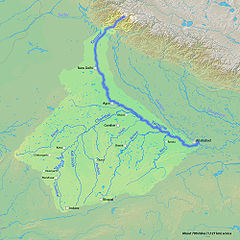
The Yamuna River originates from the Yamunotri Glacier in the Uttarakhand state of India. It flows through several states, including Uttarakhand, Himachal Pradesh, Haryana, Delhi, and Uttar Pradesh, before joining the Ganges River in Allahabad (Prayagraj).
The Mighty Course: Originating from the Yamunotri Glacier in the Garhwal Himalayas, the Yamuna embarks on a journey spanning over 1,300 kilometers. It flows through the states of Uttarakhand, Himachal Pradesh, Haryana, Delhi, and Uttar Pradesh, leaving its mark on the diverse terrains it encounters.
Confluence Chronicles: The Yamuna River is not a solitary entity; it embraces various tributaries along its journey. Key tributaries like the Tons, the Betwa, and the Chambal contribute to the Yamuna’s robust flow, shaping the landscape and ecology of the regions they traverse.
Ecological Ecosystem: The Yamuna’s course plays a vital role in supporting diverse ecosystems along its banks. From the alpine regions of the Himalayas to the plains of northern India, the river sustains a wealth of flora and fauna. Explore the unique biodiversity that thrives in the Yamuna basin, from rare species of fish to vibrant birdlife.

Cultural Significance: Beyond its geographical features, the Yamuna holds immense cultural importance. It is intertwined with mythology, featuring prominently in Hindu scriptures and epics. The river has been a witness to centuries of human civilization, influencing the development of historic cities like Delhi and Agra.
Environmental Challenges: However, the Yamuna River faces significant environmental challenges. Pollution from urban, industrial, and agricultural sources poses a threat to its water quality. Efforts to rejuvenate and protect the Yamuna are crucial for sustaining its ecological balance and ensuring the well-being of the communities that depend on it.
Conclusion: As we navigate the geographical tapestry of the Yamuna River, we uncover a story of natural beauty, cultural richness, and environmental challenges. Understanding the nuances of its geography is essential for fostering sustainable practices and ensuring the longevity of this vital waterway.
Length
The river has a total length of about 1,376 kilometers (855 miles).
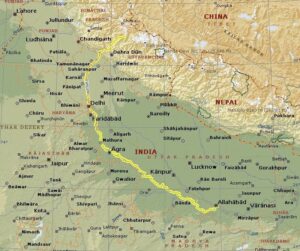
Introduction: The Yamuna River, a majestic watercourse originating in the pristine Himalayas, holds a significant place in the geography of northern India. In this blog, we’ll unravel the remarkable journey of the Yamuna as it gracefully traverses through diverse landscapes, covering an extensive length of over 1,300 kilometers.
A Himalayan Birth: The source of the Yamuna lies in the Yamunotri Glacier, nestled amidst the lofty peaks of the Garhwal Himalayas. It is here, at an altitude of about 6,387 meters, that the river begins its descent, carving a path through rocky terrains and pristine alpine landscapes.
Meandering Through States: As the Yamuna flows from its Himalayan origin, it charts a course through multiple states, becoming a geographic thread that weaves through the tapestry of India. Uttarakhand, Himachal Pradesh, Haryana, Delhi, and Uttar Pradesh all bear witness to the river’s meandering journey, each state contributing to the Yamuna’s character and length.
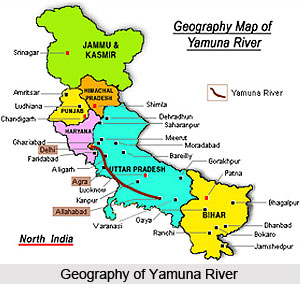
Tributaries and Confluences: The Yamuna is not solitary in its course. Along its journey, it is joined by several tributaries, each adding to its voluminous flow. The Tons, the Betwa, and the Chambal, among others, contribute to the Yamuna’s length and deepen the river’s influence on the regions it touches.
Navigating the Plains: As the Yamuna descends from the hills, it transforms into a river that navigates the plains of northern India. Here, the river widens, supporting lush agricultural landscapes and becoming a vital water source for communities along its banks.
Cultural and Historical Significance: Beyond its geographic measurements, the Yamuna’s length is enriched by its cultural and historical significance. The river has been a witness to the rise and fall of civilizations, shaping the cultural landscapes of cities like Delhi and Agra. Its banks are dotted with temples and historical sites, each narrating a tale of the river’s enduring presence.
Holiness
The Yamuna River is considered sacred in Hinduism, and it is closely associated with the legends of Lord Krishna. Many important Hindu pilgrimage sites, including Mathura and Vrindavan, are situated along its banks.

Introduction: The Yamuna River, a sacred waterway woven into the fabric of Hindu spirituality, flows with a divine grace through the heart of northern India. In this blog, we explore the profound holiness associated with the Yamuna, tracing its spiritual significance, mythological connections, and the cultural practices that have flourished along its sacred banks.
Divine Origins: According to Hindu mythology, the Yamuna is believed to be the daughter of the Sun God, Surya. Her sacred journey begins in the pristine Himalayas, descending from the Yamunotri Glacier. This divine origin imbues the river with a sense of purity and sanctity, making it a revered entity in Hindu cosmology.
Mythological Tapestry: The Yamuna is intricately woven into the epic tales of Hinduism, particularly the Mahabharata and the Puranas. Legends recount Krishna’s playful escapades along the Yamuna’s banks, emphasizing the river’s close association with the divine. The sacred city of Mathura, situated on the Yamuna’s shores, is revered as the birthplace of Lord Krishna, adding to the river’s spiritual aura.
Religious Rituals and Pilgrimages: The banks of the Yamuna are adorned with numerous ghats, temples, and sacred sites that attract pilgrims and devotees from far and wide. Bathing in the holy waters of the Yamuna is considered purifying, with devotees participating in religious rituals and aartis (ceremonial worship) along the riverbanks. Prominent ghats such as Kesi Ghat in Mathura and Vishram Ghat in Vrindavan resonate with the echoes of devotional practices.
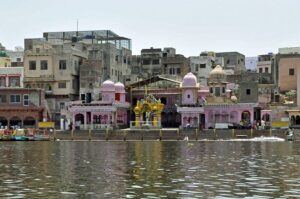
Festivals Celebrated by the Yamuna: The Yamuna becomes a central figure in various festivals celebrated with fervor along its course. The Yamuna Aarti, a ritualistic offering of light and prayers, is performed at different ghats to honor the river’s divine presence. The Kartik Purnima festival, celebrated with grandeur, involves floating diyas (oil lamps) on the Yamuna, creating a spectacle of light and spirituality.
Conservation and Spiritual Responsibility: Despite its sacred status, the Yamuna faces environmental challenges, including pollution and over-extraction of water. Many spiritual and environmental organizations have taken up the cause of Yamuna conservation, emphasizing the spiritual responsibility to protect and preserve the sanctity of this holy river.
Pollution Concerns
Over the years, the Yamuna River has faced severe pollution issues due to industrial effluents, sewage discharge, and agricultural runoff. Efforts have been made to address these concerns and improve the river’s water quality, but challenges persist.
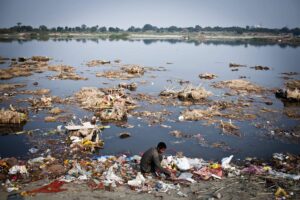
Introduction: The Yamuna River, once a symbol of purity and spirituality, now stands at a crossroads, grappling with the severe menace of pollution. In this blog, we address the critical concerns surrounding Yamuna River pollution, exploring the root causes, environmental repercussions, and the urgent need for concerted efforts to revive this once-pristine waterway.
The Perilous Descent: From its origin in the Himalayas to its journey through the plains, the Yamuna witnesses a troubling transformation. Industrial discharges, untreated sewage, and agricultural runoff contaminate its waters, turning a once-clear river into a toxic stew. The extent of pollution has reached alarming levels, posing a severe threat to both the ecosystem and the communities that depend on the river.
Urbanization and Industrial Impact: The burgeoning urban centers along the Yamuna’s course, particularly Delhi, contribute significantly to the pollution crisis. Rapid industrialization and urban expansion have led to the release of untreated industrial effluents and sewage directly into the river, compromising its water quality. The indiscriminate disposal of waste exacerbates the problem, turning the Yamuna into one of the most polluted rivers in the world.
Human Health and Ecosystem Impacts: The pollution of the Yamuna River has dire consequences for both human health and the ecosystem. Contaminated water poses a serious threat to the well-being of communities that rely on the river for drinking water and daily activities. Additionally, the once-thriving biodiversity of the Yamuna is now under immense stress, with fish populations declining, and aquatic ecosystems disrupted.

Environmental Activism and Conservation Initiatives: Amidst the gloom, there is a glimmer of hope. Environmental activists, NGOs, and concerned citizens are rallying together to address the Yamuna’s pollution crisis. Clean-up campaigns, awareness drives, and legal interventions aim to hold industries accountable and promote sustainable practices. Efforts are underway to treat sewage, regulate industrial discharges, and restore the river to its former glory.
Government Initiatives and Challenges: Government initiatives such as the Yamuna Action Plan have been launched to combat pollution and rejuvenate the river. However, the implementation of these plans faces challenges, including inadequate infrastructure, bureaucratic hurdles, and the need for a holistic approach that involves all stakeholders.
A Call to Action: The time has come for a collective and sustained effort to address the Yamuna’s pollution concerns. Public awareness, community involvement, and stringent enforcement of environmental regulations are essential components of the solution. Only through a united front can we hope to reclaim the purity of the Yamuna and ensure a sustainable future for this once-sacred river.
Water Resource
The Yamuna is an important water resource for the regions it traverses, supporting agriculture and serving as a source of drinking water for millions of people.

Introduction: The Yamuna River, a vital water resource flowing through the heart of northern India, plays a pivotal role in sustaining both the environment and the communities that depend on it. In this blog, we delve into the multifaceted nature of the Yamuna as a water resource, exploring its significance for agriculture, urban centers, and the delicate balance required to ensure its sustainable use.
A Lifeline for Agriculture: The Yamuna’s journey through the fertile plains of northern India has endowed the region with a valuable water source for agriculture. The river’s water is crucial for irrigation, supporting the cultivation of crops that form the backbone of the agricultural economy. Farmers along the Yamuna rely on its waters to nourish their fields, making it a lifeline for food production in the region.
Urban Centers and Drinking Water Supply: As the Yamuna flows through major urban centers, including Delhi, it serves as a significant source of drinking water for millions of people. Water treatment plants draw water from the river to meet the daily needs of residents. However, the challenges of pollution and over-extraction pose threats to the quality and availability of this precious resource for urban populations.
Hydropower Potential: Beyond its role in agriculture and urban supply, the Yamuna also holds hydropower potential. While not extensively harnessed currently, the river’s flow could be utilized to generate clean energy. Careful planning and sustainable practices are essential to strike a balance between energy generation and the preservation of the river’s ecological integrity.
Ecosystem Services: The Yamuna is not just a source of water; it is an intricate ecosystem that provides valuable services to the environment. Wetlands, floodplains, and biodiversity along its course contribute to the overall health of the ecosystem. Recognizing and preserving these ecosystem services is crucial for maintaining the ecological balance that supports the river’s water resources.

Challenges of Over-Extraction and Pollution: Despite its significance, the Yamuna faces severe challenges, primarily due to over-extraction and pollution. Unregulated withdrawal for agriculture and urban use has led to decreased water levels, impacting both the river’s flow and the availability of water for various purposes. Pollution from industrial and domestic sources further jeopardizes the quality of the Yamuna’s water, necessitating urgent intervention.
Sustainable Management and Conservation: Addressing the water resource challenges of the Yamuna requires a comprehensive and sustainable approach. Integrated water resource management, efficient irrigation practices, and stringent pollution control measures are essential components of any strategy aimed at preserving the Yamuna’s water resources for future generations.
Yamuna Action Plan
To address pollution and rejuvenate the river, the Indian government has implemented the Yamuna Action Plan, a series of initiatives aimed at improving water quality and restoring the ecological balance of the river.
Introduction: The Yamuna River, once a symbol of purity and vitality, has faced unprecedented challenges due to pollution and over-extraction. In response to this environmental crisis, the Indian government launched the Yamuna Action Plan (YAP), a comprehensive initiative aimed at rejuvenating and restoring the health of this sacred waterway. In this blog, we explore the intricacies of the Yamuna Action Plan and its impact on the journey to revive the Yamuna River.
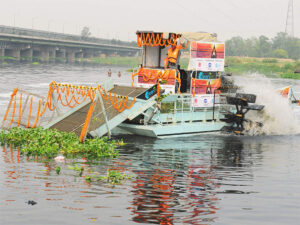
Genesis of the Yamuna Action Plan: The Yamuna Action Plan emerged in response to the deteriorating state of the Yamuna, particularly in its stretch through Delhi. Recognizing the urgent need for intervention, the government initiated the plan to address pollution, improve water quality, and promote sustainable management of the river’s resources.
Phases of the Yamuna Action Plan: The Yamuna Action Plan has undergone multiple phases since its inception. The initial phases focused on sewage treatment and pollution control, targeting the reduction of pollutants entering the river. Later phases expanded the scope to include aspects like solid waste management, afforestation, and community involvement.
Sewage Treatment and Pollution Control: One of the primary objectives of the Yamuna Action Plan is to enhance sewage treatment infrastructure along the Yamuna’s course. Treatment plants have been established to treat domestic and industrial effluents, reducing the volume of pollutants released into the river. Efforts are underway to ensure that untreated sewage no longer poses a threat to the Yamuna’s water quality.
Solid Waste Management and Afforestation: Recognizing the importance of holistic environmental management, the Yamuna Action Plan incorporates measures for solid waste management and afforestation. Proper waste disposal practices are being implemented to reduce the burden of non-biodegradable waste on the river. Afforestation along the Yamuna’s banks helps stabilize the soil, prevent erosion, and promote biodiversity.
Community Participation and Awareness: The success of the Yamuna Action Plan hinges on community participation and awareness. Various initiatives aim to engage local communities, encouraging them to actively contribute to the restoration efforts. Educational programs raise awareness about the importance of a clean Yamuna and the role each individual plays in preserving the river.
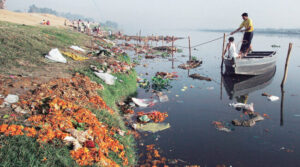
Challenges and the Way Forward: Despite the strides made through the Yamuna Action Plan, challenges persist. Enforcement of regulations, industrial compliance, and sustained community engagement are ongoing concerns. The plan requires continuous adaptation and improvement to address emerging threats and ensure the long-term health of the Yamuna.
The Impact on the Yamuna’s Future: While the Yamuna Action Plan faces challenges, it represents a crucial step towards reclaiming the Yamuna’s purity. The concerted efforts to reduce pollution, manage resources sustainably, and involve communities signal a commitment to restoring the river to its former glory.

